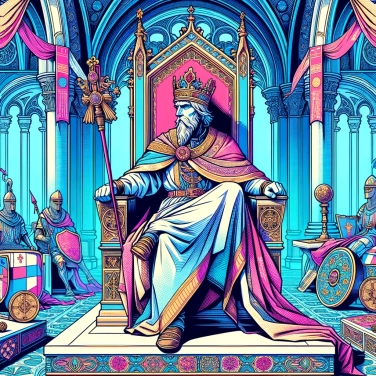Charlemagne was seated on a throne during his funeral because it reflected his position of power as emperor, symbolizing his authority even after his death.

In the Carolingian era, the throne represents much more than just a simple seat: it is an image of absolute power, divine authority, and royal prestige. Sitting on a throne is to assert oneself as superior, as chosen by God to reign on earth. Charlemagne, by being buried seated, manifested this idea of a symbolic eternal reign. It was meant to show that he continued to govern his empire symbolically even after his death. The throne also gave his image a sacred dimension, somewhat like that of a king-priest. Therefore, Carolingian thrones were powerful political instruments, constantly reminding visitors and subjects who truly wielded supreme power.
In ancient cultures, being buried sitting was not so rare. Several barbarian leaders from the Germanic or Celtic tribes had already chosen this position, often to demonstrate a position of authority beyond death. The Romans sometimes depicted their great figures seated to symbolize their role as judges or supreme leaders. Among the neighboring Germans, it was quite common to bury their kings or heroes in this posture, a way of presenting them as always vigilant, ready to watch over their people eternally. By being buried this way, Charlemagne could have adopted this ancient symbolic custom, emphasizing his exceptional status and eternal power, even after death.
Upon his death, Charlemagne is seen as a ruler different from the others: a figure who continues to reign even in the afterlife. Being buried seated on his throne is a way to show that his authority never ceases, a sort of immortal king whose reign symbolically extends beyond his disappearance. The beliefs of the time hold that the king is directly chosen by God, so imagining him as eternal emphasizes this special divine connection. This image of a king seated, forever dominating events, also helps to reinforce the idea that his empire remains strong despite the sovereign's death. It is even said that he still firmly held in his hands the symbols of power: a sword to signify his military and religious role, and a scepter to assert his limitless political dominion over time.
Historians remain divided on the reasons for the unusual choice of a seated burial. Some specialists speak of a carefully orchestrated symbolic staging to illustrate the eternal power of the sovereign. Others believe that this posture imitated ancient practices inherited from the Roman or Germanic era, particularly to pay tribute to great leaders or warriors buried in this way. On the archaeological side, it's complicated: rare primary sources and the lack of reliable details in ancient accounts make it difficult to reach a definitive conclusion. No direct remnants have survived clearly to the present day, so it remains a partial mystery, leaving many champions of the historical debate to clash with their hypotheses.
The imperial crown used to crown Charlemagne is said to have been used to anoint several subsequent emperors, becoming a powerful symbol of continuity between the ancient and medieval empires.
Charlemagne was canonized in 1165 by the antipope Pascal III, but his sainthood is not officially recognized by the Catholic Church today.
According to some medieval chronicles, Charlemagne's tomb was said to have been opened in the year 1000 by Emperor Otto III, who found his body sitting, still wearing a golden crown and holding a scepter.
In Aachen, its imperial capital, Charlemagne had a palatine chapel built, directly inspired by the Byzantine model, reflecting a desire for a symbolic connection with the heritage of Rome and Constantinople.
Yes, several ancient and medieval leaders were buried in a seated position to symbolize their rank and eternal power. This tradition has parallels among certain Celtic and Germanic tribes, as well as in late Roman antiquity.
The main historical source mentioning the burial of Charlemagne is Einhard, a contemporary historian of the emperor. He explicitly describes the emperor seated on his throne in his tomb at Aachen.
The seated tomb of Charlemagne embodies both a religious and a political dimension. Symbolically, it expresses the divine authority of the emperor while politically projecting an image of an eternal and stable reign, intended to deter attempts at challenge or dynastic upheaval.
The tomb of Charlemagne was opened several times over the centuries, notably in the year 1000 by Otto III. During this opening, it is reported that the emperor's body was relatively well-preserved, seated with a crown and holding a scepter. However, the successive openings led to the dispersion of some of the relics, further complicating the precise study of the burial conditions.
No direct archaeological evidence confirming that Charlemagne was indeed buried sitting has been reliably provided. Historical writings, such as those by Einhard, mention this fact, but the tomb has been opened several times, complicating definitive archaeological conclusions.

No one has answered this quiz yet, be the first!' :-)
Question 1/5